2.
GHANA
Third quarter exports continue downward trend
Data on contract approvals by the Timber Industry
Development Division (TIDD), show that exports of
timber and wood products continue to decline. This, say
analysts at the TIDD, is mainly due to the dwindling raw
material base.
Contracts for a total volume of 76,014 cu.m of wood
products were processed and approved by the TIDD in the
third quarter of 2011.The contract volume approved for
the period was 12% lower compared to volumes in
contracts approved during the second quarter.
The table below shows the breakdown of volumes in
contracts approved by product during the quarter under
review.
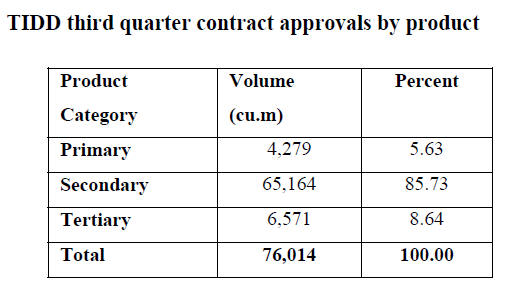
Sawnwood exports declined by 9% for the second
consecutive quarter from a volume of 28,532 cu.m in the
second quarter to 25,913 cu.m in the third quarter. Total
contract approvals for export of plywood also fell (down
12%) from a volume of 30,373 cu.m in the second quarter
to 26,734 cu.m in the third quarter.
Around 87% of the approved plywood export contracts
were for shipment within the West African market, with
the remaining 13% for the European market, particularly
Greece and Belgium.
A total of 6,366 cu.m volume of veneer export contracts
were processed and approved. The volume represented in
these contracts was down 18% on the previous quarter.
The breakdown of veneer exports by product is as follows:
sliced veneer (4,778 cu.m, representing 74.5%); rotary
veneer (1,585 cu.m representing 25%) and very small
quantity of high value curl veneer.
Exports of teak poles/billets/logs also declined dropping
from a volume of 13,324 cu.m in the second quarter to
4,279 cu.m in the third quarter, a drop of 68%. However,
the volume of teak sawnwood in approved export
contracts increased from 3,038 cu.m in the second quarter
to 5,051 cu.m in the third quarter.
Contracts processed and approved for the export of
rosewood also increased. For the third quarter fifteen
permits were issued for the export of 1100 cu.m of
rosewood sawnwood to China at a value of Euro 278
million.
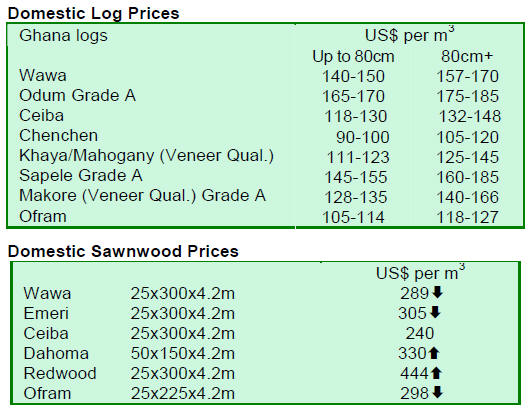
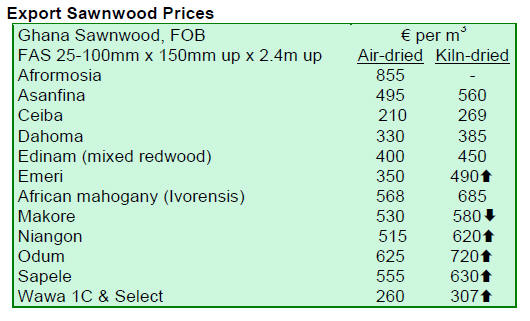
¡¡
3.
MALAYSIA
Some progress in negotiations with EU on VPA
The Malaysian Ministry of Plantation Industries and
Commodities has indicated that some progress has been
made in talks with the European Union (EU) concerning
the Voluntary Partnership Agreement (VPA).
The Ministry had emphasised that specific forestry laws
apply in Peninsular Malaysia, Sabah and Sarawak and this
must be appreciated before any agreement could be
reached.
The Ministry is reportedly looking at the possibility of
these regions signing the agreement at different times.
While Peninsular Malaysia is apparently ready to sign the
VPA, the states of Sarawak and Sabah have issues to be
discussed, particular in relations to customary land rights
of forest dwellers.
When the VPA is signed between Malaysia and the EU,
the EU will provide a virtual ¡°green lane¡± for certified
Malaysian timber into the EU market. The EU Timber
Regulation will come into force in March 2013 and this,
when enforced, will close EU markets to timber from
countries where there is a high risk of illegally harvested
timber being traded.
Analysts point out that the VPA is crucial to Peninsular
Malaysia as most of its timber products are exported to the
EU, whereas Sarawak¡¯s main markets are Japan and lately,
India. However, without a VPA, value added products
manufactured from Sarawak timbers in third countries will
face problems entering the EU market.
The EU Timber Regulation, as well as the enforcement of
the US Lacey Act, are triggering changes in both private
and public procurement procedures and policies in other
countries such as Japan and Australia.
The Ambassador and Head of Delegation of the EU to
Malaysia has reportedly indicated that the entry of
Malaysian timber and timber products into the EU to be
facilitated under the VPA would enhance the image and
competitiveness of Malaysian wood products in the EU.
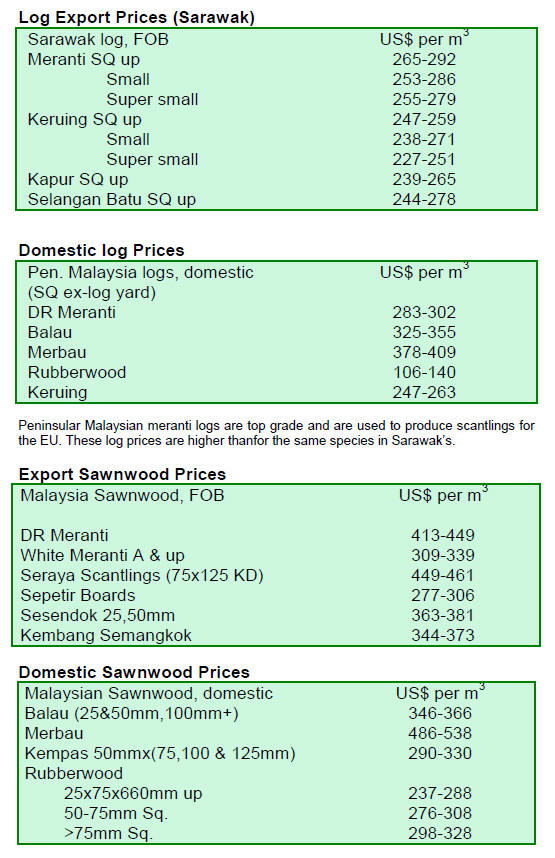
4.
INDONESIA
Indonesia to implement a ¡°Green Prosperity
Project¡±
The United States has reportedly pledged US$450 million
for an environmental and climate change cooperation
programme with Indonesia.
The money will be utilised to fund projects for the
promotion of environmentally sustainable economic
growth, strengthening climate change policies,
conservation of tropical forests, protecting coastal
communities and fisheries as well as the Low Emission
Development Strategies (SOLUSI) project to improve air
quality.
The US will, reportedly, assist Indonesia to implement
a
¡°Green Prosperity Project¡± at a cost of US$332.5 million,
which will support environmentally sustainable economic
growth through the enhancement and management of
Indonesian forests, peat lands and other natural resources
as well as the development of renewable energy.
In addition, the US will provide US$6.9 million to
match
funding from Norway for the new Indonesian Climate
Change Centre (ICCC), which will deploy and provide the
mapping and monitoring of carbon-rich peat lands and
tropical forests, with expertise to be provided by the US
Forest Service.
The aim is to provide Indonesia with the best available
scientists and policy analysts on key strategies and
decision making from the US to mitigate and adapt to
climate change.
Concerning the conservation of Indonesia¡¯s tropical
forests, the US and Indonesia had earlier signed a second
Tropical Forest Conservation Act Agreement (TFCA) in
September. This provides for a debt-for-nature swap of
US$28.5 million in order to support tropical forest
conservation in Indonesia.
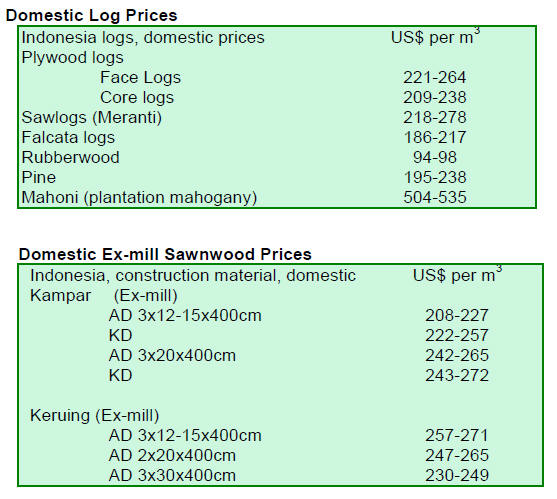
5. MYANMAR
Tender sale of logs for local
manufacturers
About 400 tons of Sawing Grade teak logs (SG5, SG6, and
SG7) were sold in early November by open tender for
local sawmillers and manufacturers. The following prices
per hoppus ton were obtained.
SG-5 €1881 (31 tons)
SG-6 €1251 (30 tons)
SG-7 €491 (351 tons)
Unlike other open tender sales this special sale was
only
open to local industries who will process the logs. Logs
purchased in this type of auction cannot be exported.
Weakening Indian rupee affecting sales of
Pyinkado
The trade is reporting that the market outlook is slow for
all major species such as pyinkado, gurjan (kanyin) as well
as teak.
The major buyer for these species is India and
because the
rupee is weakening log dealers are facing difficulties in
securing usual prices. Many buyers are reportedly very
cautious with their purchases.
The Vietnamese dong has also weakened and this is
affecting sales of teak and pyinkado to Vietnam and the
volumes being purchased have fallen sharply.
However, dealers are saying that logs that are
fresh, of
large girth and of moderate price can be sold quickly.
The market for kanyin (gurjan) started showing
weakness
in August and analysts say there is little chance of any
recovery until January/February when newly extracted
fresh logs are expected to arrive in Yangon.
MTMA blames trade sanctions for over harvesting
Speaking on the side-lines of the Asia Forest Partnership
(AFP) Dialogue 2011 in Beijing, a representative of the
Myanmar Timber Merchants Association (MTMA)
remarked that economic sanctions are severely limiting
Myanmar¡¯s economy have forced the government to
become reliant on wood product exports to support the
state budget.
However, one analyst remarked that, at present, it
is rather
the stagnation in the European economies and weak global
demand that are affecting the economy in Myanmar as
much as sanctions.
An analyst close to the MTMA suggested that Myanmar
should start engaging boldly with the EU as soon as
possible and get involved with the FLEGT process to
secure a long term future for sales of timber products to
Europe when the political conditions are right.
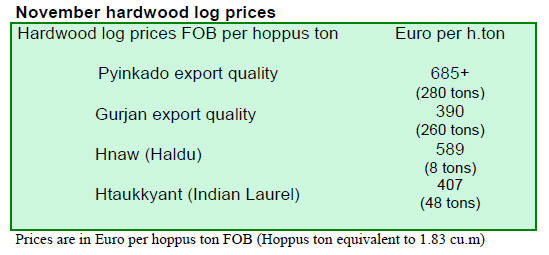
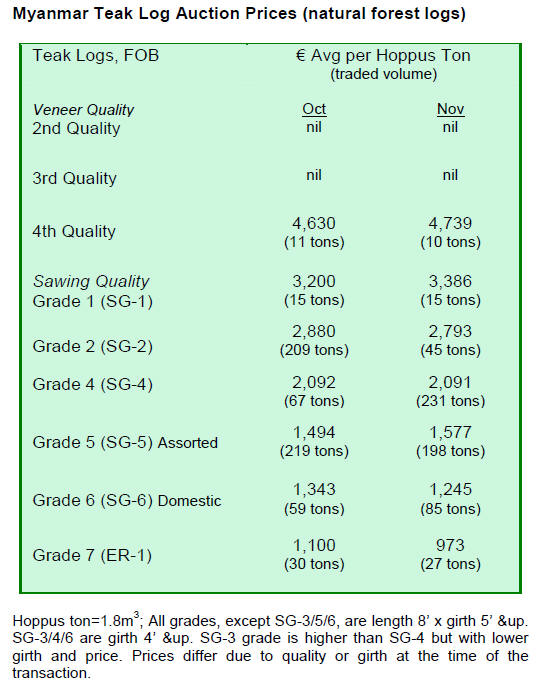
6.
INDIA
Sliding rupee set to alter
timber trade performance
India¡¯s increasing trade deficit, along with the withdrawal
of investments by investors from Europe and N. America,
has added to the toll on the value of Indian rupee against
all major currencies.
With rupee now at Rs.52 to the US dollar imports are
set
to decline and analysts see the timber sector taking a
cautious approach to new contracts. Buyers are seeking the
understanding of their suppliers. However, the weakening
currency is a blessing to exporters who have had to live
with a strong rupee for much of this year.
Negative impact of teak plantations on
biodiversity
Reports suggest that there has been a drastic reduction in
the wild animal population in forest areas of Melghat in
the Amravati division of Vidarbha region.
This area produces good quality teak and other
hardwoods
such as Chloroxylon swietenia, Adina cordifolia,
Terminalia tomentosa, T. chebula and also T.belerica. The
region is famous for its tiger reserves covering an area of
about 1571.74 sq.kms.
In recent years teak plantations have been
established in
areas close to the various parks. The effect of the teak leaf
fall and consequent rapid drying of the soil in the dry
summer months has resulted in many water pools drying
out depriving wildlife of a water supply.
The Forestry Department has realised that the area is short
of fruit bearing and flowering trees which provide food for
the wildlife and has temporarily stopped teak plantation
development and is focussing on re-introducing native
species as well as bamboo.
Auction sales in Government Forest Depots.
With fresh logs now being made available for auction at
the log depots, prices are beginning to move beyond the
firm levels reported at previous auctions.
Auctions have been held recently in Western and
Central
Indian depots. Approximately 5,000 cu.m of teak logs
were sold. Analysts report that sales were brisk and prices
were high but that imported logs now are costing more due
to the depreciation in value of the rupee.
E-commerce set to grow to US$24 billion
According to a recent study by Avendus, the widespread
use of the internet will provide for sustained growth in the
Indian e-commerce market which, the study suggests,
could grow to US$24 billion by 2015 up from the current
US$6.3bil.
Avendus reports that around 8-10 million people in
India,
about 11 per cent of the 80 million internet users in the
country, use the internet for some form of business.
Sweden¡¯s IKEA explores opportunities in Indian
retailing
The India Business Standard has reported that, because of
the changes made by government to the rules on FDI in
the retail sector, the Swedish furniture maker IKEA may
be one of the first to open retail outlets in the country.
IKEA executives were apparently recently in India to
assess the opportunities created by the changes in
legislation.
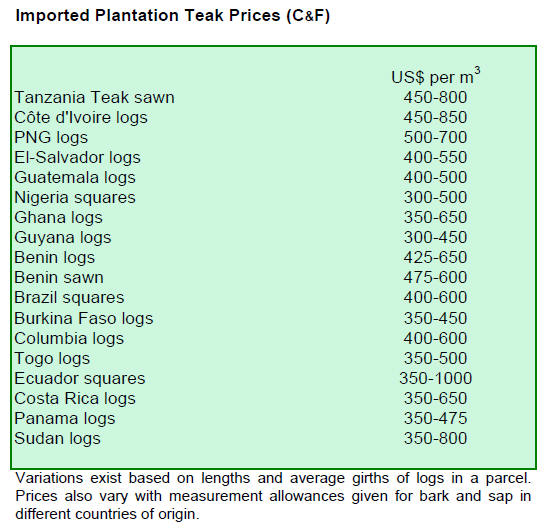
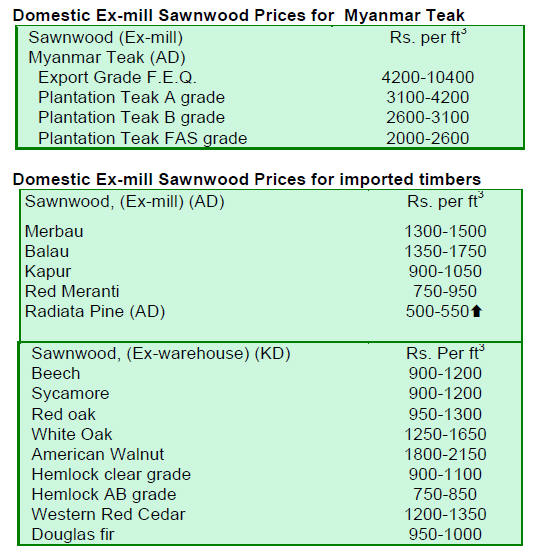
7. BRAZIL
Much of Amazon harvested by informal
sector
Around three million trees are harvested every year in the
Amazon says the Environmental Agency and the timber
market based on this resource is estimated to be worth
over R$ 4 billion. However, authorities estimate that only
a small part of the overall harvest is undertaken by the
timber industry.
The timber industry generally has the necessary
approvals
for logging but the environmental agency says much of the
Amazon harvest is done by the informal sector and much
of the harvesting by this sector is without the necessary
approvals and is therefore illegal.
Native Amazon trees to be used in reforestation
Reforestation with native species is now being given
serious consideration. Paric¨¢ (Shizolobium amazonicum) is
a tree that grows fast and produces high quality wood.
Paric¨¢ is the most widely cultivated tree species native to
the Amazon forest.
Parica timber is used in civil construction and furniture
manufacturing. Paric¨¢ is widely used for plywood
production because the logs are clear of defects and are
cylindrical. Despite the importance of Paric¨¢ for the
Amazon region, the genetic improvement of this species
has not attracted attention but the Brazilian Agricultural
Research Corporation (Embrapa) is now conducting
research on genetic improvement of this species.
Tropical timber trade figures shrunk in October
In October 2011, exports of wood products (except pulp
and paper) fell 8% compared to levels in October 2010,
from US$ 213.7 million to US$ 196.8 million.
October pine sawnwood exports increased 20% in
value
compared to the same month last year, from US$ 12.9
million to US$ 15.5 million. In terms of volume, exports
increased 19%, from 57,000 cu.m to 68,000 cu.m over the
period.
Exports of tropical sawnwood declined slightly in
October, from 45,100 cu.m in October 2010 to 45,000
cu.m in October 2011. There was a sharper drop in terms
of value however, from US$ 21.6 million this October
compared to US$ 23.8 million in October 2010.
Pine plywood exports fell 15% in value in October
2011
compared to the same month of 2010, from US$ 28.6
million to US$ 24.2 million. The volume exported slid
21% during the same period, from 80,800 cu.m to 63,800
cu.m.
Exports of tropical plywood recorded a sharp drop
from
6,900 cu.m in October 2010 to 5,700 cu.m in October
2011, (a 17% decrease). In value, a 10.3% decrease was
registered, declining from US$ 3.9 million to US$ 3.5
million.
As for wooden furniture, the exported value dropped
from
US$ 48.6 million in October 2010 to US$ 44.3 million in
October 2011, representing a 9% decline year on year.
International Furniture Fair in Brazil.
Two major trade fairs scheduled for 2013
The Association of Furniture Industries of the State of Rio
Grande do Sul (MOVERGS) is preparing for two major
events to be held in 2013, in São Paulo, Brazil. One will
be the International Machinery, Raw Materials and
Accessories Fair for the Furniture Industry (FIMMA
Brazil). This show is widely recognised for product
designs from furniture manufacturers who excel in
technological innovation.
It is hoped that this 11th ¡®FIMMA Brazil¡¯ will
exceed the
level of business opportunities achieved at the 10th
FIMMA held this year which attracted some 675
exhibitors and more than 43,000 visitors. This show
generated US$403 million in business transactions.
The second major fair will be that sponsored by
MOVERGS, the ¡®Brazil M¨®veis¡¯ to be held in August
2013 in Sao Paulo, Brazil.
The ¡°Brasil Moveis Fair 2011¡± held in Brazil in
August
this year brought together 128 exhibitors from various
furniture production centres in Brazil and from overseas.
The 2011 fair attracted more than 20,000 visitors
and
generated about R$290 million in business transactions.
Policy changes to promote competitiveness of
furniture sector
A government Committee on the Forest-Based Industry
and the Federation of Furniture Industries of Rio Grande
do Sul (FIERGS) has been discussing prospects for forestbased
products, paper, cardboard, pulp and furniture. The
Association of Furniture Industries of the State of Rio
Grande do Sul (MOVERGS) is a member of the
Committee, along with other associations and unions
linked to the forest sector.
In order to promote furniture exports MOVERGS has
raised the issue of the new industrial policy and tax
regimes with the federal government.
MOVERGS has requested the speedy release of the
adjusted Federal tax credits as the reimbursement process
for these claims is taking a considerable time. The Federal
Revenue Service of Brazil takes a long time to make
payments to companies, arguing the lack of personnel to
conduct efficient processing of these claims.
Another request from industry concerns the creation
of an
exchange rate policy that will make the export sector more
competitive. The furniture industry says it is most
competitive when the exchange rate is in the range of
R$2.05 to R$2.25 to the dollar and would welcome policy
initiatives that facilitates the industry in securing such
exchange rates.
If this is not possible, say exporters, then the
government
should take other measures such as tax exemptions or
monetary compensation from the Federal Government
since, without support, there will be little or no prospect
for an increase in exports in the short- to medium- term.
MOVERGS has also requested a review of the
legislation
to reduce the bureaucracy so that a greater number of
companies can benefit from the special tax drawback
regime.
In addition, there is a claim for suspension of
import taxes,
federal taxes and taxes on goods and services related to the
import of machinery and equipment by the furniture
sector.
Slight weakening of real depreciates affects
price
structures in the local market
Wood product prices in BRL, increased marginally at the
end of November compared to prices recently published.
Prices in USD, as shown in the table below rose around
7% due to the weakening of the Brazilian currency against
the US dollar during the period reviewed.
In October 2011, the average exchange rate to the US
dollar was BRL 1.77/USD compared to BRL1.68/USD
during the same month of 2010, which shows a slight
weakening of the Brazilian currency against the US
currency.
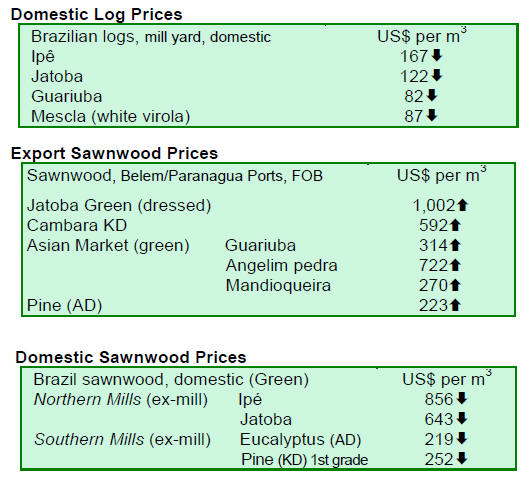
8. PERU
First timber production
cluster established
The first timber production cluster in the country will be
located in the Ucayali region as there is a wide variety of
woods available and because technological developments
in the public and private timber sectors are well
developed.
To ensure success of the cluster the government
will
apparently provide support from the Center for
Technological Innovation (CITE), Wood (CITEmadera
Pucallpa) and the Bureau of Competition. It was revealed
that arrangements are being made to optimise the
operational capability of the technology transfer unit of
Pucallpa CITEmadera and promote the development of
timber and related businesses in the region.
Risk of illegal logging increased by lack of
land titles
The lack of land titles in Huanuco in the Pillco valley in
central peru is a factor that compounds the problem of
illegal harvesting of forest products according to the head
of the Technical Administration of Forestry and Wildlife
(ATFFS).
Since land users do not have land titles they tend
to over
exploit accessible forests with harvesting being done
without management plans or annual operating plans that
provides for sustainability.
The official from ATFFS explained that, for
example, in
Puerto Inca illegal harvesting had reached a critical level
because of a lack of personnel and logistics to control the
situation.
In the same area approved forest concessions are
gradually
being encroached by farmers employing shifting
cultivation.

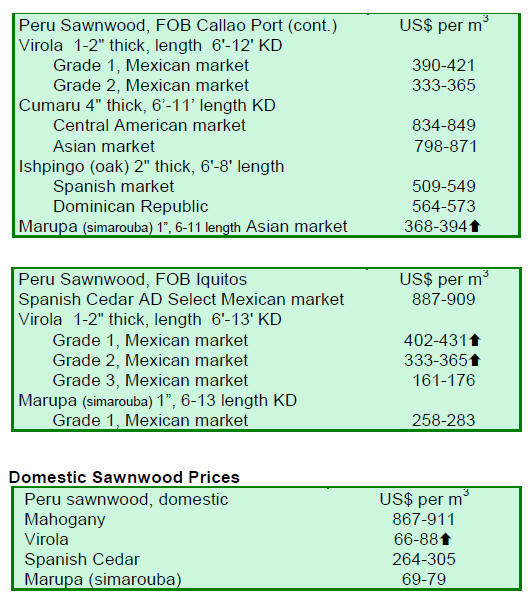
9.
GUYANA
Greenheart logs out of favour in export
markets
During the fortnight under review there were no exports of
Greenheart logs and this extends the period where there
were no exports to four weeks.
Purpleheart logs were shipped to international
buyers but
prices dropped for all sawmill qualities logs, similarly
export prices of sawmill quality Mora sawnwood fell.
Sawnwood prices mixed in widening range for
several species
Undressed Greenheart (select) sawnwood prices slide from
US$806 to US$636 per cubic metre, however prices for
Greenheart (sound) improved compared to levels two
weeks ago.
Undressed Purpleheart (select) secured better
prices for
this fortnight, rising to US$1,050 in comparison to the
US$997 per cubic metre received over the previous
fortnight. Undressed Mora sawnwood prices remained
relatively stable during the period under review.
Dressed Greenheart sawnwood prices were mixed and
the
range of prices received from international buyers
widened. For the period under review the best price
recorded was US$1,350 per cubic metre while at the other
end of the scale prices dipped to between US$615 to
US$650 per cubic metre.
Prices for Dressed Purpleheart sawnwood eased from
US$996 to US$912 per cubic metre.
There were no exports of Plywood for this fortnight
period.
Capacity building to improve efficiency and
value
added processing
As part of GFC/ITTO project ¡°Enhancing the capacity of
wood processing sector to improve efficiency and value
added in Guyana¡±, the Government of Guyana is involved
in creating a new policy and code of practice for wood
processing industries.
Existing policy documents have been reviewed and
several
consultations were conducted with stakeholders to gather
information and data on the present situation in the wood
processing sector.
As part of the process, recovery studies were
conducted in
mills using different equipment, technologies and practices
to compare efficiency within the industry. The
information gathered was then used as the basis for the
development of relevant policies and a Code of Practice
(CoP) for the wood processing sector.
In order to develop this CoP a national
consultative
process was undertaken with stakeholders to define the
practices and subject matter to be addressed in the CoP.
The result of this exercise is a report detailing findings and
recommendations which has been used to develop
relevant policies, such as those related to the
implementation of the CoP for wood processing and a
strategic plan for capacity building within the wood
processing.
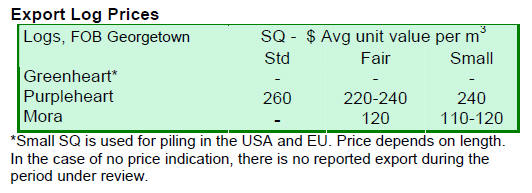
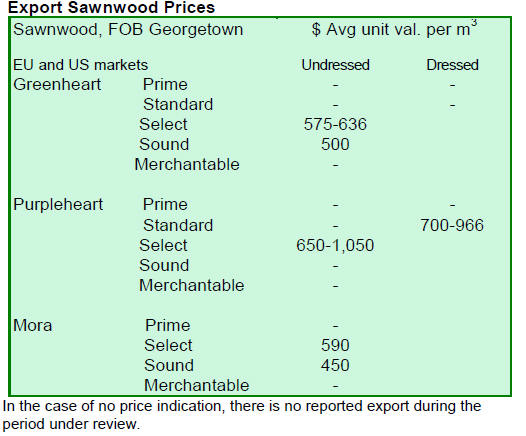
Related News: